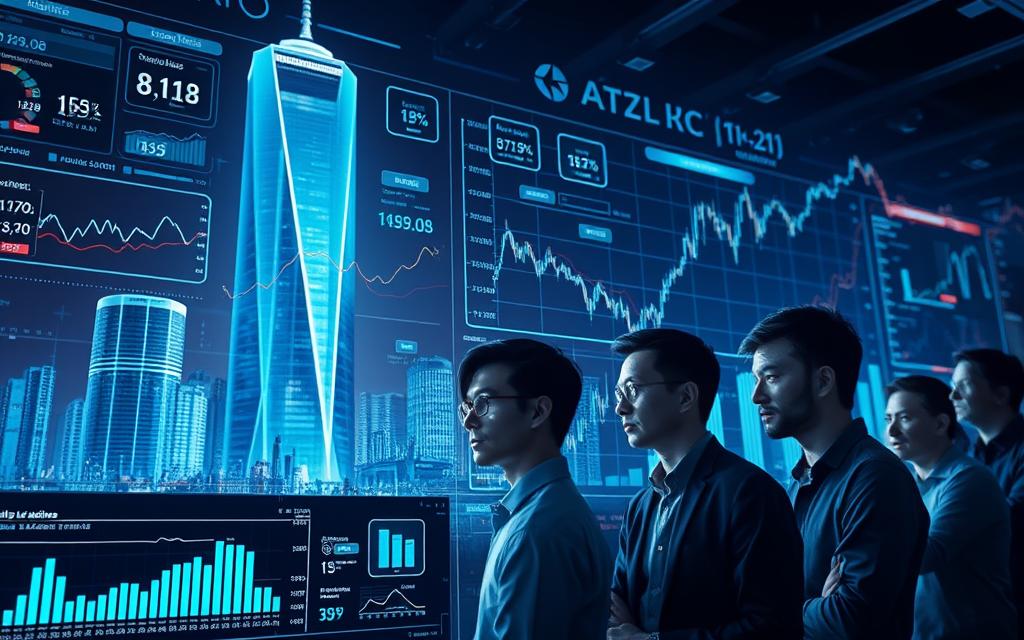The world of digital assets is evolving fast. Advanced algorithms now analyze vast amounts of data to forecast market movements. This raises an important question: can technology outperform human traders in volatile conditions?
Machine learning models process historical patterns, social sentiment, and global economic factors. They generate insights that challenge traditional analysis methods. Some platforms already show impressive results, with certain assets projected for significant growth.
Yet skepticism remains. Unexpected events and sudden shifts in investor behavior can disrupt even the most sophisticated models. The debate continues between those trusting data-driven forecasts and traders relying on experience.
This article examines how modern tools approach market forecasting. We’ll explore their strengths, limitations, and real-world performance in the unpredictable world of digital finance.
Understanding AI-Powered Crypto Price Predictions
Sophisticated algorithms now decode complex patterns in volatile markets. These tools analyze vast datasets to identify trends invisible to the human eye. Recurrent neural networks, for example, process 30-day volatility metrics like Sleepless AI’s 18.62% fluctuation rate.
How Learning Models Analyze Market Patterns
Pattern recognition thrives on historical performance. Sleepless AI’s 13 green days out of 30 (43% positive momentum) train models to spot bullish signals. Over five years, price channels refine accuracy for long-term projections.
Key indicators like the 14-Day RSI (43.53) reveal neutral conditions. This balance helps algorithms adjust forecasts during sideways movements.
The Role of Historical Benchmarks
Moving averages anchor predictions. Sleepless AI’s 50-day SMA ($0.171777) and 200-day SMA ($0.415988) act as critical support levels. These data points validate trends across different time frames.
However, historical factors falter during regulatory shocks or exchange hacks. Models struggle to account for unprecedented events, reminding traders to blend automation with human judgment.
The Science Behind AI Price Prediction Crypto Models
Quantitative models transform raw market data into actionable trading signals. These systems blend technical analysis, behavioral trends, and real-time volume shifts to project movements. Below, we dissect the core components powering these forecasts.
Technical Indicators Used by Prediction Algorithms
Pattern recognition begins with tools like Bollinger Bands. Sleepless AI’s $0.12-$0.18 daily range helps identify overbought or oversold conditions. When prices touch the band edges, algorithms flag potential reversals.
Moving averages anchor predictions. The 200-day EMA ($0.418021) and SMA ($0.415988) divergence highlights trend strength. Wider gaps suggest accelerating momentum, while convergence signals consolidation.
| Indicator | Value | Signal |
|---|---|---|
| Williams %R | -14.48 | Oversold |
| Stochastic RSI | 100 | Sell |
| Hull MA (9) | $0.12 | Support |
Sentiment Analysis and Social Media Factors
Social sentiment metrics track crowd psychology. The Fear & Greed Index (neutral at 0) quantifies emotions driving demand. Algorithms scan platforms like Twitter for abrupt shifts in tone.
Positive mentions may precede rallies, while panic spikes often correlate with sell-offs. However, sentiment alone rarely dictates long-term trends—volume confirms its impact.
Volume and Volatility Considerations
30-day volatility metrics (18.62%) reveal risk levels. Higher fluctuations demand adjusted position sizing in strategies. Volume-weighted averages (VWMA) highlight institutional activity.
For example, Sleepless AI’s VWMA (10) at $0.12 aligns with its Hull MA, suggesting balanced supply and demand. Such convergences validate trend stability.
Explore how these models integrate on-chain metrics for deeper insights.
Current Market Predictions: A Reality Check
Forecasting tools promise impressive returns, but how do they hold up under scrutiny? Recent projections for digital assets like Sleepless AI show dramatic swings—from April 2025’s $0.139952 low to May’s $0.665478 high. These numbers demand a closer look.
Analyzing Projected Performance
The 371.29% ROI claim hinges on breaking the 50-day SMA resistance at $0.171777. Historical data shows only 43% green days, suggesting volatility. While May 2025’s $0.461666 target (+229.87%) seems ambitious, past accuracy rates temper expectations.
Short-Term vs Long-Term Accuracy
Short-term forecasts struggle with sudden sentiment shifts. Long-term models, like the 2026 $0.184558–$0.389557 channel, show more stability. Yet, the 538.60% 2029 projection conflicts with declining RSI momentum—a red flag for investors.
Reading Between the Lines
Not all predictions are equal. Tools weigh factors differently:
| Factor | Weight | Impact |
|---|---|---|
| Historical Trends | High | Strong for stable assets |
| Social Sentiment | Medium | Volatile during news cycles |
| Technical Indicators | Critical | RSI, SMA validate trends |
Key takeaway: Blend automated insights with manual analysis. No tool fully accounts for black swan events.
How to Use AI Predictions in Your Crypto Strategy
Modern traders blend technology with traditional strategies for better results. While forecasts highlight opportunities, success depends on how you apply them. Here’s how to integrate data-driven insights without overreliance.
Incorporating Predictions Into Technical Analysis
Use tools like Sleepless AI’s $0.116572 support level to set entry points. Pair this with Bollinger Bands to confirm trends. For example, a $1,000 position could target 371.29% ROI if resistance breaks.
Action steps:
- Cross-verify forecasts with on-chain data
- Set stop-loss orders 14.48% below predicted prices
- Track 50/200-day SMA crossovers for trend shifts
Setting Realistic Expectations for Returns
Not all assets deliver equal value. Historical data shows only 43% positive days for volatile picks. Allocate 2-5% of your portfolio to high-risk plays.
| Strategy | Potential ROI | Risk Level |
|---|---|---|
| Short-term (37 days) | 371.29% | High |
| Long-term (2029) | 538.60% | Moderate |
Balancing AI Insights With Fundamental Analysis
Algorithms miss regulatory changes or black swan events. Combine automated signals with qualitative research. Quarterly rebalancing based on SMA trends helps maintain stability.
Key takeaway: AI tools enhance decisions but shouldn’t replace critical thinking. Diversify assets, manage risk, and stay updated.
Technical Indicators You Should Monitor
Successful traders rely on key metrics to navigate volatile markets. These tools reveal hidden patterns in price movements and help identify optimal entry points. Mastering them transforms raw data into actionable trading strategies.
Understanding Moving Averages
Simple Moving Averages (SMA) and Exponential Moving Averages (EMA) highlight trend directions. Sleepless AI’s 50-day SMA ($0.171777) currently diverges from its EMA ($0.209928), signaling potential momentum shifts.
This 22.2% gap suggests accelerating buying pressure when prices cross above both lines. Traders watch these convergences to confirm trend strength before committing capital.
Interpreting Oscillators
The Relative Strength Index (RSI) at 43.53 indicates neutral market conditions. However, extreme readings like the 100 Stochastic RSI flag overbought assets. These tools work best when combined.
Other momentum indicators:
- Awesome Oscillator at -0.03 shows bearish pressure
- ADX reading of 48.43 confirms strong trend development
Support and Resistance Levels
Critical price zones define risk-reward ratios. Sleepless AI’s pivot point sits at $0.130524, while Fibonacci projections span $0.116572 to $0.478191. Breaching these levels often triggers significant movements.
| Indicator | Current Value | Trading Signal |
|---|---|---|
| 50/200 SMA Cross | $0.171777/$0.415988 | Potential bullish reversal |
| 14-Day RSI | 43.53 | Neutral conditions |
| Fibonacci 0.618 | $0.478191 | Key resistance zone |
Combine these tools for comprehensive market analysis. No single indicator guarantees success, but together they provide a clearer picture of value and risk.
The Limitations and Risks of AI Forecasting
While automated forecasts offer valuable insights, they carry inherent risks that every investor should understand. Models excel in stable markets but falter during sudden shifts. Recognizing these weaknesses helps refine strategies.
When Prediction Models Fail
Extreme volatility breaks even advanced algorithms. Sleepless AI’s 2027 projection of $0.116549 contradicts its 2025 optimism, showing a 51.31% variance. Such swings reveal model fragility.
Key factors that disrupt forecasts:
- Liquidity crunches (30-day volatility: 18.62%)
- DeFi protocol failures in the ecosystem
- Smart contract vulnerabilities
Regulatory and Black Swan Events
SEC rulings can erase projected gains overnight. The 2030 floor of $0.449003 assumes stable regulations—a rare scenario. Always weigh legal risks against potential rewards.
The Myth of Guaranteed Returns
Past performance metrics like 43% green days don’t ensure future success. The 2049 $6.35 ceiling relies on sustained adoption, ignoring market saturation risks.
| Threat | Impact | Mitigation |
|---|---|---|
| Regulatory shifts | High | Diversify across jurisdictions |
| Liquidity shortages | Critical | Monitor volume-weighted averages |
| Model overfitting | Moderate | Cross-validate with fundamental analysis |
Pro tip: Seek professional investment advice to balance automated tools with human judgment. No model predicts every market twist.
Conclusion
Digital asset markets demand both innovation and caution. While tools forecast future price swings like 2029’s $0.901736 peak, the 2030 correction to $0.449003 shows volatility. Investors must balance short-term 29.28% gains with long-term 538.60% projections.
Combine automated outputs with macroeconomic trends and sector adoption rates. Never rely solely on bold ROI claims—risk management matters more. Audit your portfolio quarterly using fresh market data.
Remember, past performance (43% green days) doesn’t guarantee results. Use AI as one tool among many, not a crystal ball. Stay informed, stay flexible, and always verify.












